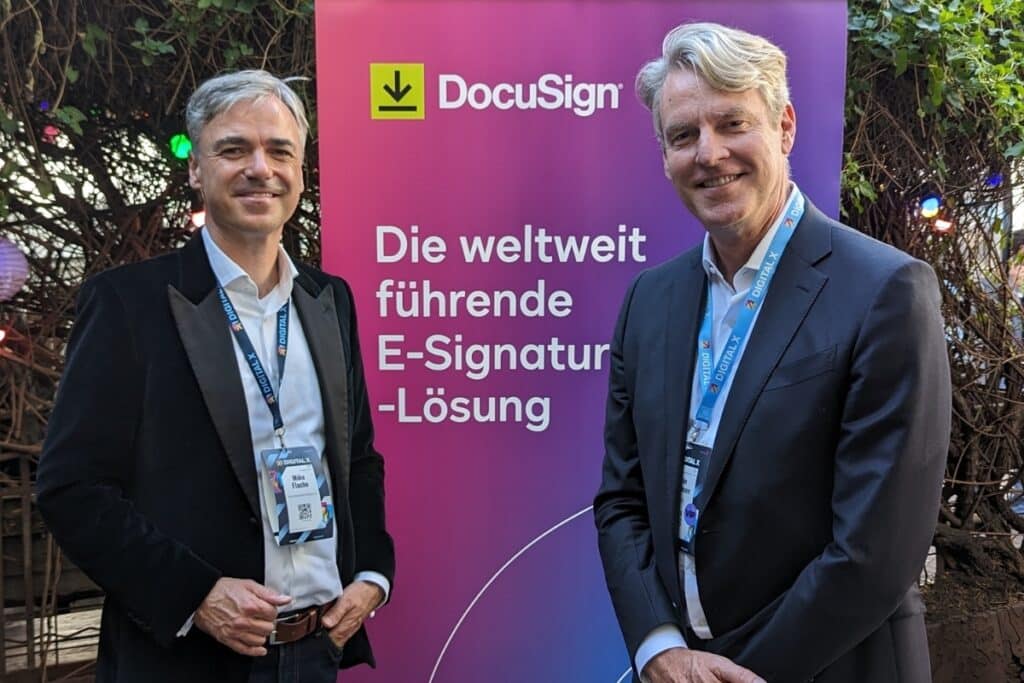The article was originally published in German on DocuSign.
Business efficiency is critical because it directly impacts a company’s profitability and growth potential. Two good reasons why I am convinced that the topic is essential, and I would like to provide further insights in this article.
Companies can optimize their business efficiency in several key areas:
- Operations involve streamlining processes and increasing productivity. Organizations can achieve this by implementing lean manufacturing principles, automating tasks, and eliminating waste.
- Supply chain management involves optimizing the flow of goods and services from suppliers to customers. Organizations can achieve this by using technology to track inventory levels, improving communication with suppliers, and reducing lead times.
- Customer service involves improving the customer experience by providing quick and efficient service, resolving issues promptly, and maintaining high levels of customer satisfaction. Organizations can achieve this by investing in technology to track customer interactions, providing training to employees, and implementing customer feedback programs.
Discovering underestimated efficiency potential
Against this background, my current interest is particularly in contract lifecycle management (CLM) and electronic signatures (e-signature). Both topics are self-evident in the corporate environment, so the associated optimization potential is often underestimated.

I met with Allan Thygesen, CEO of DocuSign, about these aspects at Digital X in Cologne. Our conversation revolved around business value, efficiency, and sustainability and the requirements for organizations in Germany and Europe in a global context.
DocuSign gave me the opportunity to delve deeper into the topics together. Although I have already worked with the solution myself, it was even more exciting to see the positive effect on business efficiency and scaling.
Why it’s worth investing in business efficiency
Transforming established processes in organizations of all sizes is challenging — especially in today’s fast-paced business environment. The arguments I often hear are “too time-consuming” and “too expensive”. Is that actually the case?
By investing in CLM and e-signature technology, companies can automate many of its repetitive and time-consuming tasks related to contract management, such as creating contracts, tracking changes, and managing renewals. That frees up valuable resources and allows employees to focus on more strategic and value-adding activities that help grow the business.
E-signature can also streamline the contract signing process, making it faster, more convenient, and more secure. By enabling parties to sign contracts electronically, organizations can reduce the need for physical paperwork, which can be a significant source of delays and errors. That helps speed up the contract signing process, reduce costs associated with printing and mailing, and improve overall contract management efficiency.
In summary, investing in improving business efficiency helps organizations stay agile and adaptable in the face of changing market conditions and customer demands. By continually evaluating and improving processes, organizations can identify areas for improvement and make changes quickly to respond to changing business needs.
The challenges for contract lifecycle management and electronic signature
CLM and electronic signature are both processes that have greatly improved the efficiency of business transactions. However, they also come with their own set of challenges.
Contract lifecycle management
- Ensure that all parties involved in the contract are on the same page
- Communicate contract changes effectively
- Track the status of the contract when multiple departments and stakeholders are involved
To overcome these challenges, organizations can implement the following practices:
- Set clear guidelines for communication and ensure that everyone involved is aware of the terms of the contract
- Use contract management software to keep track of the status of the contract and any changes made
- Assign a contract manager who is responsible for overseeing the entire contract lifecycle and ensuring all parties are aware of any updates or changes
Electronic signature
- Ensuring the security and authenticity of the signature
- Enforcing electronic signatures in certain situations due to legal uncertainties
To overcome these challenges, organizations can implement the following practices:
- Use digital signature software that meets the appropriate security standards to prevent fraud and ensure that the signature is legally binding
- Stay abreast of any changes in the legal landscape surrounding electronic signatures to ensure they are enforceable in all situations
Mast-Jägermeister Group use case

During my dialogue with Allan Thygesen, we also talked about concrete examples. By using DocuSign, the German Mast-Jägermeister Group saves an entire hour for each document signed in the organization. This is enormous potential when I think about economies of scale, both within the organization and in terms of integration across different industries. Not to be forgotten are the countless tons of paper that can be saved every year.
Going paperless and improving processes
For the Mast-Jägermeister Group, introducing DocuSign e-signature was necessary in order to meet its objectives of simplifying the signing process and reducing paper consumption and reliance. DocuSign e-signature is currently being used by various departments within the Mast-Jägermeister Group, with each department adapting it to suit their needs. Across the company, DocuSign e-signature is significantly improving security and speeding up contract turnaround times—thus empowering the organization to meet its business objectives.
Increasing business efficiency through contract lifecycle management and electronic signature
Contract Lifecycle Management (CLM) and electronic signature (e-signature) are two powerful tools that can significantly increase business efficiency. CLM is a process that includes the creation, negotiation, execution and management of contracts. On the other hand, e-signature refers to the use of digital signatures to sign documents.
Some benefits that companies can take advantage of are:
- Improved compliance: With CLM, businesses can ensure that they are complying with relevant laws and regulations. This is achieved by automating compliance checks and ensuring that contract terms are in line with legal requirements. e-signature also provides an audit trail that can be used to prove compliance in case of an audit or legal dispute.
- Better collaboration: CLM allows for better collaboration between different departments and stakeholders involved in the contract process. By providing a centralized platform for contract creation, negotiation, and approval, businesses can ensure that all parties are on the same page. e-signature also makes it easier for multiple parties to sign documents, even if they are located in different parts of the world.
- Cost savings: By automating various tasks involved in the contract process, businesses can save money on administrative and legal costs. e-signature eliminates the need for printing, scanning, shipping documents, and analogously storing, which can be costly in terms of time and money.
- Improved customer experience: CLM and e-signature can also improve the customer experience. By making the contract process faster and more convenient, businesses can provide a better experience for their customers, partners, and vendors. This can lead to increased customer loyalty, repeat business, and a credible perception of a contemporary organization.
Trust is a critical consideration
In the context of Contract Lifecycle Management (CLM) and electronic signatures (e-signature), trust plays a crucial role in ensuring successful contract execution and compliance. Trust is the foundation of any business relationship, and it is particularly important when it comes to contracts.
In the absence of trust, parties involved in a contract may face numerous challenges that can affect their business relationships, including legal disputes and loss of revenue. The following are some additional points to consider regarding trust in CLM and e-signatures:
- Trust is a two-way street, and it is essential that all parties involved in the contract have faith in each other’s abilities and intentions. This can be achieved through transparency, open communication, and a clear understanding of each party’s responsibilities and obligations.
- E-signatures require a high level of trust to ensure their validity. To establish trust, e-signature providers use various authentication methods, such as multiple-factor authentication or biometric verification, to verify the identity of signatories and prevent fraud.
- The qualified electronic signature (QES) offers a particularly high level of security. In addition to the technical assignment to ensure the traceability of the document to be signed, personal or digital identification as well as two-factor authentication takes place.
- In addition to establishing trust in the e-signature process, it is also important to ensure that the contract terms are clear and unambiguous. This can help to prevent misunderstandings and disputes down the line.
Conclusion
Contract lifecycle management and electronic signature are a valuable investment for businesses of all sizes. It can help to streamline their operations, reduce costs, and improve customer satisfaction, while also providing a foundation for future growth and innovation.
Trust is a critical consideration in the context of CLM and e-signatures. To maintain a positive business relationship, it is important to build trust between stakeholders — with trusted eIDAS providers to guarantee compliance.
What I learned from my experience with DocuSign is that their solutions meet the needs of forward-thinking companies looking to transform their entire agreement process to be efficient and compliant. It is not for nothing that DocuSign is a EU Trust Service Provider.

